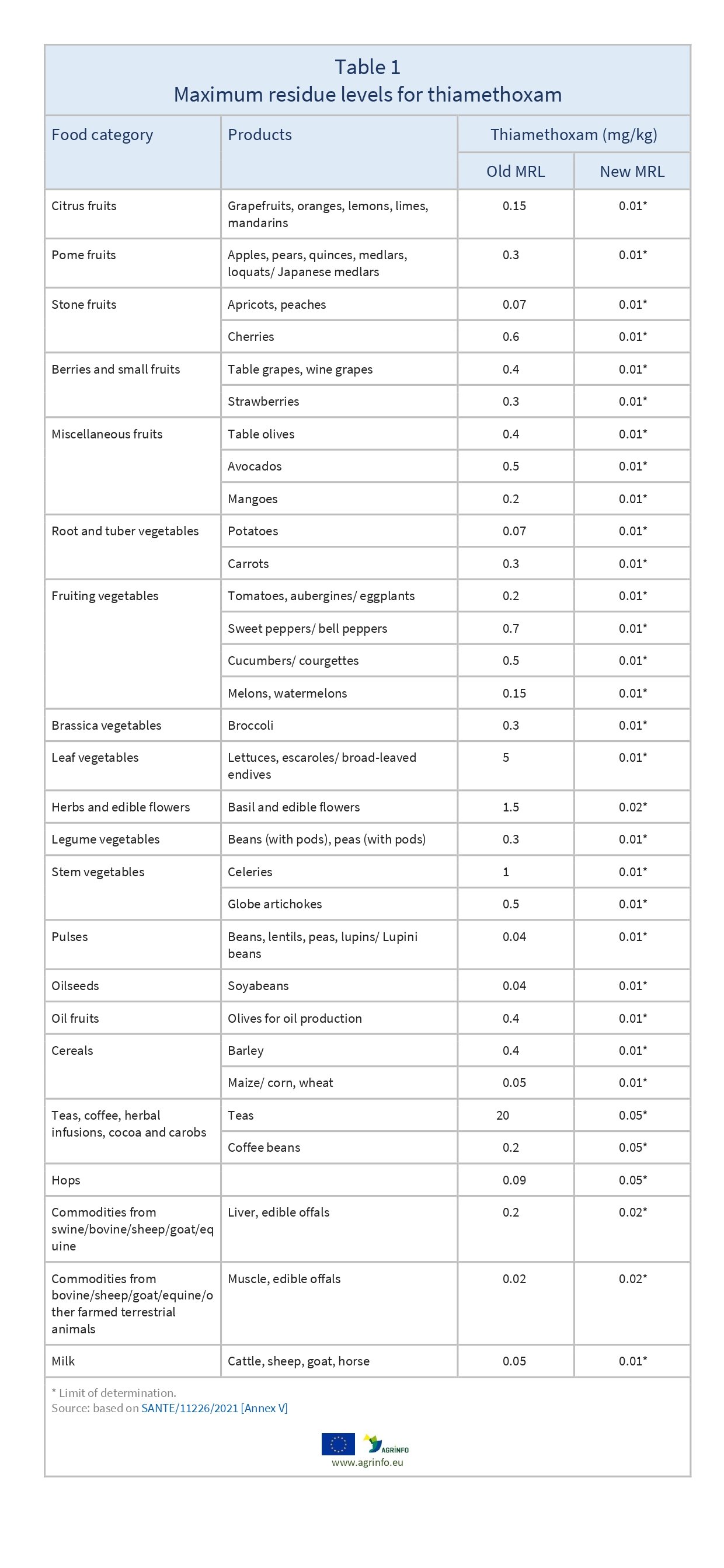Maximum residue levels for thiamethoxam
- Pesticide MRLs
Summary
On 15 February 2023, the European Commission published Regulation 2023/334 reducing the maximum residue levels (MRLs) for thiamethoxam to the limit of analytical determination (LOD) (the lowest level that can be detected using the most modern and reliable analytical methods). For thiamethoxam, these range between 0.01 and 0.05 mg/kg. There are implications for exporters of fruit, vegetables, cereals, teas and coffees, and animal products.
EU reduces MRLs for thiamethoxam on all products, with impacts on fruit, vegetables, cereals, teas and coffees, and animal products
Commission Regulation (EU) 2023/334 of 2 February 2023 amending Annexes II and V to Regulation (EC) No 396/2005 of the European Parliament and of the Council as regards maximum residue levels for clothianidin and thiamethoxam in or on certain products
Update
On 15 February 2023, the European Commission published Regulation 2023/334 reducing the maximum residue levels (MRLs) for thiamethoxam to the limit of analytical determination (LOD) (the lowest level that can be detected using the most modern and reliable analytical methods). For thiamethoxam, these range between 0.01 and 0.05 mg/kg. There are implications for exporters of fruit, vegetables, cereals, teas and coffees, and animal products.
Impacted Products
grapefruits, oranges, lemons, limes, mandarins, apples, pears, quinces, medlars, loquats/ Japanese medlars, apricots, peaches, cherries, table grapes, wine grapes, strawberries, table olives, avocados, mangoes, potatoes, carrots, tomatoes, aubergines, eggplants, sweet peppers, bell peppers, cucumbers, courgettes, melons, watermelons, broccoli, lettuces, escaroles, broad-leaved endives, basil and edible flowers, beans (with pods), peas (with pods), celeries, globe artichokes, beans, lentils, peas, lupins, Lupini beans, soyabeans, olives for oil production, barley, maize, corn, wheat, rice, teas, animal products
What is changing?
The European Commission proposes changes to the MRLs for thiamethoxam as summarised in Table 1.
In addition, on other fruits, vegetables (except herbs), pulses and oilseeds not included in Table 1, the MRLs will be reduced from 0.02 to 0.01 mg/kg. The MRLs on animal products that are not included in Table 1 are increased from 0.01 to 0.02 mg/kg, reflecting the lowest level that can be reliably detected with current analytical methods (the limit of determination, LOD).
Why?
In 2016, the Intergovernmental Science-Policy Platform on Biodiversity and Ecosystem Services on pollinators, pollination and food production concluded that neonicotinoids (including thiamethoxam) have adverse effects on bees and other pollinators (IPBES 2016). EFSA (2018) found that the use of thiamethoxam outdoors poses significant risks to bees. The Commission therefore restricted its use to greenhouses. Following these restrictions, applications for the renewal of thiamethoxam were withdrawn.
Where a substance is not reapproved, the EU typically reduces MRLs to default levels, but will take into account established Codex MRLs (CXLs). In this case, the Commission argues that CXLs based on good agricultural practices (GAP) for outdoor use are not acceptable due to the effects on bees. The EU wishes to avoid contributing to this global environmental problem. This proposal aims to ensure that all products are imported “free from clothianidin and thiamethoxam” [recital (12)].
Timeline
The Regulation enters into force on 25 February 2023. The new MRLs will apply from 7 March 2026.
What are the major implications for exporting countries?
Thiamethoxam is approved for a wide range of agricultural, viticultural and horticultural uses. In the case of pests such as aphids, effective control is essential not only to reduce damage by the pests themselves, but also to prevent them acting as vectors of serious viruses and other diseases.
Since restrictions on neonicotinoid pesticides were introduced in 2013, several EU Member States have granted emergency authorisations for thiamethoxam, as no alternative products or methods (chemical or non-chemical) were available, or because there was a risk of pest resistance developing to available alternative products (EFSA 2021). However, in January 2023, the European Court of Justice (ECJ) ruled that emergency authorisations for thiamethoxam are no longer permitted (C-162/21).
Producer experience in the EU suggests that the reduction of MRLs on thiamethoxam may also be a major challenge for countries exporting to the EU market.
Exporting countries must find alternative products or methods to control pests in the coming 3 years. The Commission considers that “adaptation of agricultural practices can be reasonably expected to be achieved after two growing seasons” [recital (19)].
Recommended Actions
Suppliers to the EU market of fruit, vegetables, cereals, teas and coffees, and animal products should review their current use of thiamethoxam with a view to seeking alternative solutions in anticipation of the reduction in MRLs in 2026.
Background
MRLs are set in accordance with the rules set out in Regulation 396/2005. For information on current MRLs for other substances, please consult the EU Pesticide Residues database.
Resources
Sources
Commission Regulation (EU) 2023/334
Tables & Figures

Source: Commission Regulation (EU) 2023/334
Disclaimer: Under no circumstances shall COLEAD be liable for any loss, damage, liability or expense incurred or suffered that is claimed to have resulted from the use of information available on this website or any link to external sites. The use of the website is at the user’s sole risk and responsibility. This information platform was created and maintained with the financial support of the European Union. Its contents do not, however, reflect the views of the European Union.
